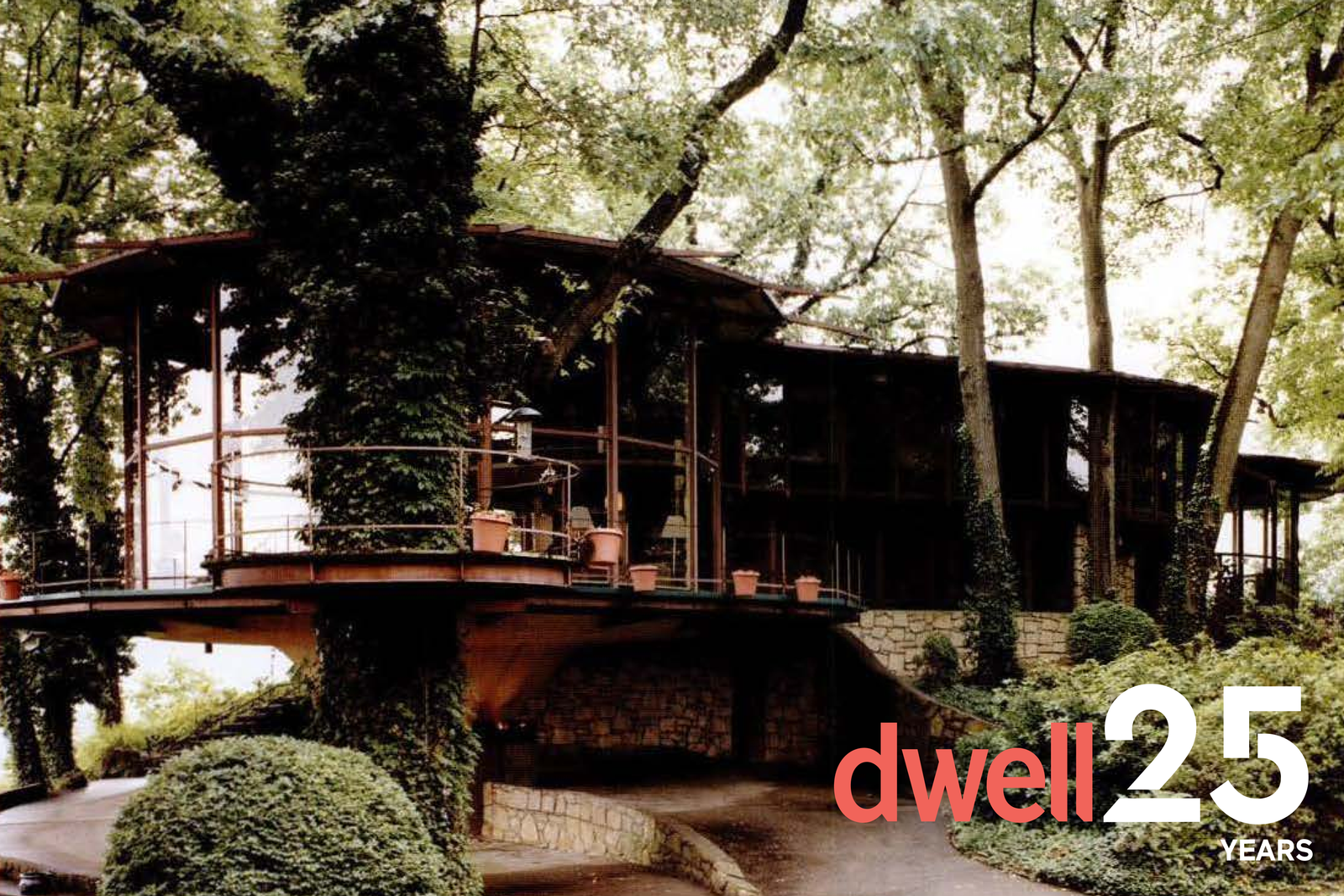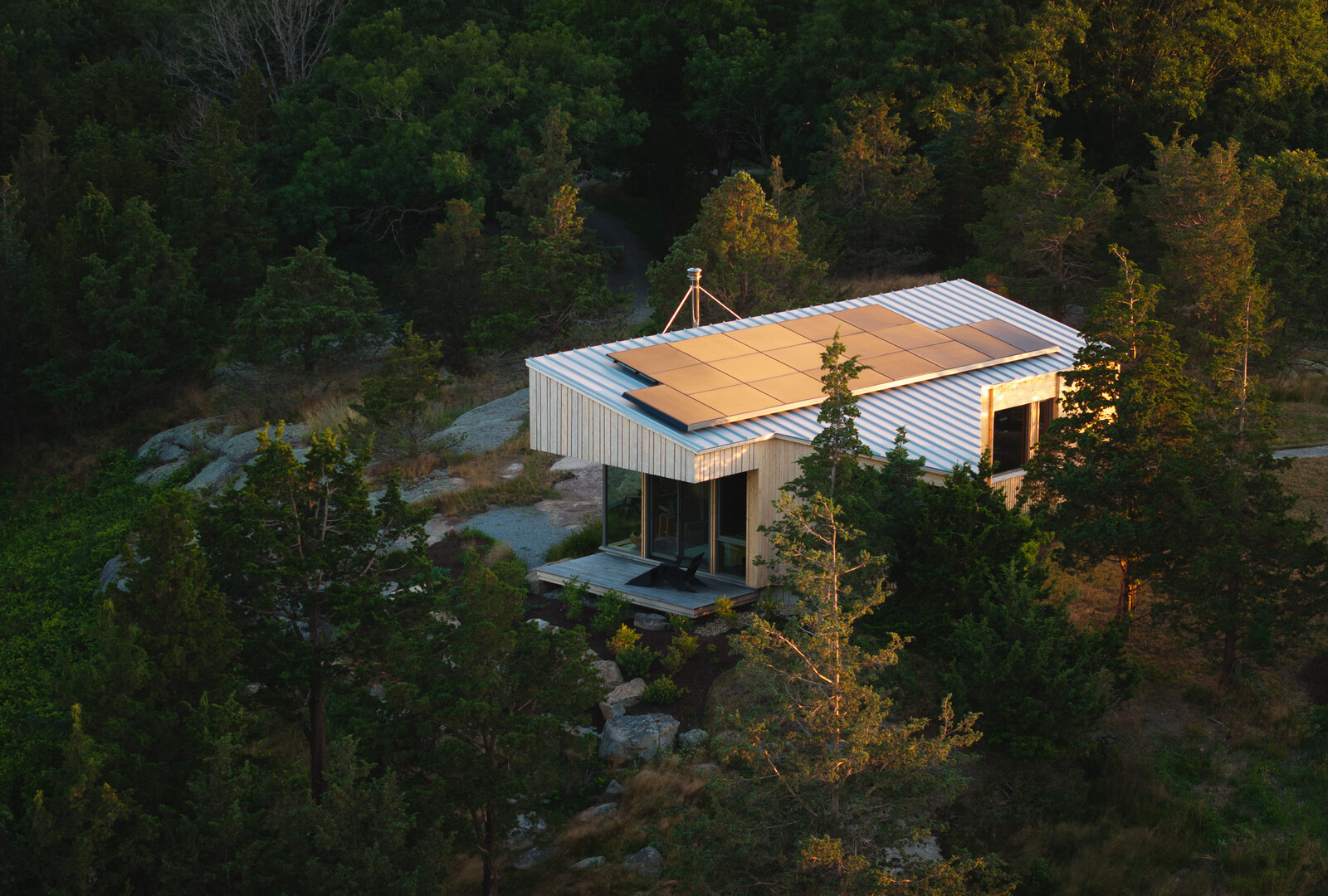In the early aughts, we explored how across the country, people shunned the colonial and Mediterranean fantasias offered by developers and invented their own avant-garde.
As a part of our 25th-anniversary celebration, we’re republishing formative magazine stories from before our website launched. This story previously appeared in Dwell’s October 2001 issue.
Charleston, West Virginia
In the field of architecture, there is no shortage of eccentric visionaries. But few are as endearing as Henry Elden. His singular worldview is what led him to design Top-O-Rock, his stunning home and studio that is resolutely unlike any other in the city, let alone the state. But unlike a Wright, a Johnson, or a Howard Roark, the spry 87-year-old (he’d just returned from a ski vacation in Europe when we met) doesn’t characterize his home as a work of genius—he calls it “a real party house. I’ll be here ‘til they carry me out feet first.”
Top-O-Rock, named for the ledge on which it sits, is located in a former stone quarry overlooking downtown Charleston and the Kanawha River. Its design makes the utmost of this spectacular panorama, thanks to 10,000 square feet of floor-to-ceiling glass. The house is composed of two circular structures. The larger is the office, the smaller the house. Elden designed this “live/work space” in the late ’60s before the term “live/work” really meant anything. “I’ve worked at home since 1948,” he recounts. “I think my daughter was 12 before she realized her dad had a job.” His constant presence clearly influenced the paths his children have taken. Daughter Barbara Scavullo is an interior designer now living in San Francisco and son Ted, who lives next door in a house he designed and built, became an architect.
“I crawled around on his drafting table, played with building blocks. It was sort of inescapable,” explains Ted. Whereas Henry’s house is all circular forms, Ted’s (dubbed “LittleRock”) is straight lines and angles. Though father and son were trained as architects, they are clearly quite partial to the complexities of structural engineering. The younger Elden learned a lot from his father and is quick to give credit where credit is due.” For my house, I went with hyperbolic parabolas—you know, like a Pringle’s potato chip,” he explains. “It’s a complex form with a simple generation. As for Dad, his house is a jigsaw puzzle, quite elaborate in its framework. Every curve in the place is different. His intelligence and cleverness are evident.”
The two work together in an architectural practice devoted mostly to hospitals, offices, and schools. Given the conservative architectural climate in West Virginia, they have yet to receive any commissions for Rock-style residences. But they soldier on. “There is nothing like this [house] in Charleston. And I’ve never had a client ask me to do anything like it,” Henry muses. “But I had an idea and I was able to execute it. How many people can say that?”

Photos by Matthew Hranek
Grand Rapids, Michigan
In certain parts of America—say, Southern California or the beach communities along the South Fork of Long Island—no one would give a boxy, flat-roofed house like Ray Kennedy’s a second glance. Grand Rapids, Michigan, however, is not one of those places.
But Kennedy, who lives with his wife, Ann, the manager of a medical office, and his teenage daughter, is the director of Herman Miller for the Home, known for manufacturing and selling a line of furniture dominated by midcentury all-stars Ray and Charles Eames and George Nelson. He is by trade—and by inclination—a modernist.
“I follow the works of Richard Meier,” explains Kennedy. “I adore his sense of scale.”
“He came to me and said he wanted a white box,” recalls Kim DeStigter, a partner in a local firm, DeStigter/Smith Architects, best known for its work in historic restoration.
From certain angles, the big house (2,900 square feet) on Dean Lake, just outside the city of Grand Rapids, bears a passing resemblance to something Meier might have built. And there is a hint, if you look at it from the back, where it steps down to the lake, of the Cubism that Kennedy says he was after.
But, when it comes right down to it, the house that brings a whiff of the avant-garde to the cottage-lined waterfront was designed from the inside out.
“Kim forced us into focusing on programming aspects,” Kennedy recalls. What was most important to the Kennedys was a wide open space for entertaining, a unified kitchen, living room, and dining area with floor-to-ceiling glass. “The view was a primary design feature,” says DeStigter, who notes that walls of glass are extremely rare in Michigan homes, which are primarily intended as places to hide from winter’s fury.
DeStigter adds, “It was nice to have somebody who didn’t bring me five Better Homes and Gardens and say, ‘This is what I want.’”

Photo by Ethan Hill (Kennedy Residence), Photo by Scogin Mayo (Dogtrot House)
Lawrence, Kansas
“We decided to do this as a spec house because we couldn’t find anybody to have as clients,” says architect Dan Rockhill when describing the enclosed dogtrot house he designed and built on a once-vacant lot in Lawrence, Kansas. “So we produced a building we liked and hung a For Sale sign on it. Eventually Jennifer emerged as the champion of our interests—and of her own.”
Jennifer McKnight wouldn’t have been anyone’s obvious choice to move into this long industrial rectangle with flush steel windows and a corrugated aluminum roof. The owner of two used-clothing stores, McKnight had been living in a traditional Victorian and she wasn’t looking to move. Then she ran into a real estate agent friend who told her she just had to see the Rockhill house. McKnight, who now lives there with her partner, Spencer Sievers, her collection of vintage clothing, and her dog, fell in love with the place right away.
Dogtrot was influenced by local forms like the old GMC city buses that used to roam the streets of downtown Lawrence. Its galvanized steel staircase was inspired by the railroad grain-loading facilities nearby. Recycled materials are used liberally and inventively—the kitchen cabinets, for example, were made from reconstituted garbage bags.
But how does this modern structure play in an antebellum university town? Locals have egged Rockhill’s projects, and spray-painted them, too, but their objections, he insists, “only make me want to irritate them more.”
“There’s a lot of new concepts in Lawrence that everyone hates at first and then five years later become their favorite thing,” McKnight theorizes. “Dan’s work is like that. It has added a new dimension to the city.”
In response to which, the curmudgeonly architect softens his stance. “I’m very happy here despite all of my grumblings. I’ve been able to build 12 projects in town. What other city can you do that in?”
—A. A.

Photos by Jeff Jacobson
See the full story on Dwell.com: From the Archive: Iconoclasts Who Reimagined the American Home
Related stories:



